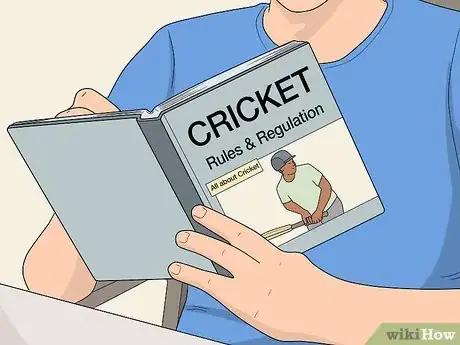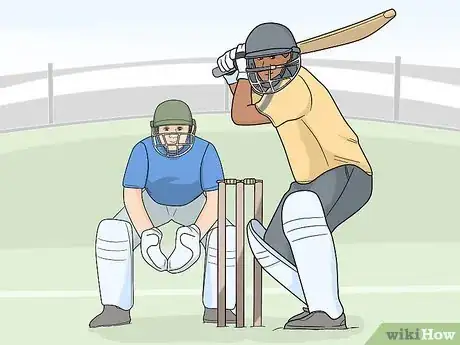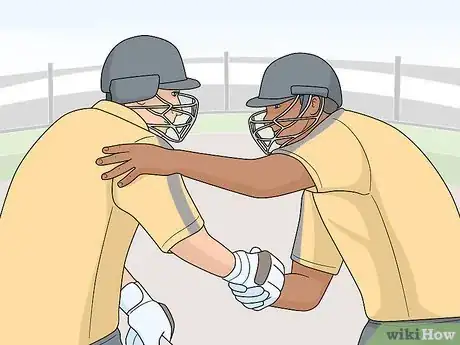This article was co-authored by wikiHow Staff. Our trained team of editors and researchers validate articles for accuracy and comprehensiveness. wikiHow's Content Management Team carefully monitors the work from our editorial staff to ensure that each article is backed by trusted research and meets our high quality standards.
There are 8 references cited in this article, which can be found at the bottom of the page.
wikiHow marks an article as reader-approved once it receives enough positive feedback. In this case, 96% of readers who voted found the article helpful, earning it our reader-approved status.
This article has been viewed 190,822 times.
Learn more...
In the sport of cricket, the main role of the captain is to act as a sort of intermediary between the coaching staff and the rest of the team. Unlike other sports, a cricket captain is part player, part coach, and must be able to successfully balance the various pressures that come with the dual responsibilities. Excelling as a cricket captain requires you to have a thorough understanding of how the game is played, a knack for strategizing, and the ability to lead your teammates both on and off the field.
Steps
Having What it Takes to Become Captain
-
1Develop a thorough understanding of the game. Study the basic rules and regulations, as well as more advanced plays and theories, until you know them like the back of your hand. Whereas the duties of guiding the team fall to the coaching staff in most other sports, the captain of a cricket team is largely responsible for calling the shots. For this reason, it’s imperative that you have a good grasp of the intricacies of the sport.[1]
- Chances are that you’re already quite familiar with the sport if you’re in the running for team captain (or hope to be soon). However, there’s always more to learn.
- Become a devoted student of the game—attend regional events, watch televised matches, and read books on gameplay and psychology. Everything you take in will become a part of your tool set.
-
2Keep a cool head in stressful situations. There are a thousand things that can go wrong during a game of cricket. As a leader and example to your fellow players, it’s your job to prepare as best you can for the sorts of challenges and setbacks you can predict, and to learn to overcome the ones you can’t. If you crack when the stakes are high, your teammates may lose motivation and feel like they’ve been hung out to dry.[2]
- Don't become panicked or frustrated when the opposing team has a sizable lead. Just concentrate on the next play, then the next, then the next, one at a time. Fixating on too many things at once will only leave your energy and attention divided.
- Mental strength is perhaps the single most important attribute that a cricket captain can possess. After all, no amount of talent will lead you to victory if you’re already defeated in your own mind.[3]
Tip: Remember, getting upset about how you're playing won't help you play any better. All it will do is prevent you from giving 100% to the task at hand.
Advertisement -
3Know your teammates’ unique strengths and skills. Watch your fellow players closely and make a note of where they play their best game. Not only is this essential for establishing the batting order, it will also allow you to implement winning tactics on the fly. For example, if your best bowler has a tendency to choke under pressure, knowing when to swap them out could mean the difference between a win and a loss.[4]
- It’s also helpful to recognize when another player may have a better grasp of strategy than you do. If you’re not very good at putting together a backup plan when a play goes awry but one of your teammates is, asking them for their advice will be in everyone’s best interest.
- One common mistake that skippers make is thinking that they have to manage everything themselves. It’s much wiser to treat each aspect of the game as a collaborative effort, including captaincy.
-
4Be prepared to stand by, and live with, your decisions. As team captain, much of the responsibility for the successes and failures of the team rests on your shoulders. This means that you must be willing to accept the outcome of the direction you provide, for better or for worse. You’ll have good games and bad games. Try to take them both in stride with a sense of humility.[5]
- Learn to trust your gut when it comes to making calls that you’re uncertain about. It will rarely lead you astray.[6]
- Resist the urge to blame your teammates when things don’t work out the way you’d hoped. This will only make you look petty and self-centered, which is not how a good leader should be.
Leading Your Team to Victory
-
1Use the pre-game toss to gain an early advantage for your team. If you have lots of capable bowlers, you might choose to rack up as many runs as possible while the pitch is still nice and smooth, knowing you can make up ground later on if need be. In other cases, you may opt to bowl while you’ve got a clear path ahead of you and plenty of daylight left. It’s always wise to consider the condition of the pitch when making your decision.
- In recent years, some leagues have begun doing away with the traditional coin toss, instead giving the visiting team the privilege of choosing their first play.[7]
Tip: If possible, look up the win percentage of teams batting first or second at the ground where you’re playing before the match and take these stats into account when making your call.
-
2Play with the same focus and intensity you expect from your teammates. All the best cricket captains lead by example. Whenever your time comes to bat or bowl, give it everything you’ve got. A consistently solid performance will earn your team’s respect and fuel their desire to win.[8]
- One of a skipper’s unofficial duties is to inspire and motivate their fellow players. There’s no better way to do this than to put in a rousing performance each and every time you take to the pitch.
- You don’t have to be a star player to be a great cricket captain. In fact, some of the best skippers of all time have been average players who just happened to have a head for planning, strategizing, and organizing managing manpower.[9]
-
3Rotate players judiciously when needed. When you find yourself in a situation where you need to adjust the batting order or cut a player from the lineup, try to do it in a tactful way to prevent clashing egos or hurt feelings. Communicate your reasons to the players involved clearly, and be ready to back up your decision with cold, hard stats and figures.[10]
- Assure your teammates that your personal feelings haven’t factored into your decision, and that you’re only doing what you think is best for the team.
- If you give a player reason to believe that they’ve been dropped or rotated unfairly, they may accuse you of playing favorites or engaging in team politics, which is not something you want to have to deal with.
-
4Be willing to give newer players a fair chance. There are skippers who prefer to always play the “best” batsmen and bowlers. However, this approach can easily backfire as the most active players grow tired and lose focus. You never know when a well-timed lineup change could revitalize your team and give them the energy they need to steal or maintain the lead.[11]
- The irony of never letting someone play because you don’t think they’re good enough is that they’ll never have the opportunity to improve.
- If you’re worried about a poor performance affecting your chances of winning, assign young and less experienced players to batting positions 7-11 in innings where mistakes are less likely to have disastrous repercussions.
Showcasing the Necessary Leadership Skills
-
1Conduct yourself in a professional manner at all times. A cricket team’s captain is expected to be a paragon of sportsmanship both on and off the field. Always be polite and courteous, and make it your goal to show as much respect to members of the opposing team as you do to your own coach and fellow players.[12]
- It’s especially important to make sure you’re on your best behavior during pre- and post-game interviews, special events, and other occasions where you’re interacting with the public.
- In many ways, the captain is the face of the team. If people don’t think very highly of you, your team’s image may suffer, as well.
-
2Be open to input from your teammates. Make time for your fellow players and encourage them to come to you with questions, concerns, critiques, and suggestions for how to make the team better. At the end of the day, cricket is a team sport, and it takes more than one player to take a team running like a well-oiled machine.[13]
- Your teammates are likely to have valuable insights to share, since they each occupy a unique position in relation to the other players and therefore have a unique perspective on the way matches unfold.
- Just because you’re receptive to outside ideas doesn’t mean you always have to put them into practice. Weigh the feedback you get carefully and determine whether it’s actually beneficial before figuring out what to do with it.
-
3Resolve conflicts within your team quickly and fairly. Nothing saps morale and sabotages performance like in-fighting. Whenever a confrontation arises between your teammates, be the one to step in and keep the peace. Work with all parties involved to reach a compromise that everyone can live with, or if necessary, ask them to put aside their differences long enough for you to finish the game.[14]
- Do your best to avoid looking like you’re choosing sides, even if you think one side is clearly in the right. Doing so could alienate one of your players, and a single weak link is all it takes to break the chain.
Warning: Be careful not to write off every blow-up as “drama.” Most players don’t play well when they’re upset, which means keeping your team happy is a practical matter.
-
4Make enjoying the game a top priority. Even though a good cricket captain has to know how to keep players focused and in-line, there is such a thing as being too strict. If you’re the high-strung type, you may need to loosen up a bit and get back in touch with the things that made you fall in love with the sport in the first place. There’s no point in playing if no one is having fun.[15]
- Keep in mind that not all cricket enthusiasts take the game as seriously as others, especially if your team is part of an amateur league. Many will just be happy to be outside and play their favorite game.[16]
- Think of having fun as a strategy in itself, if you need to. The better a time your teammates are having, the better they’re likely to perform.
Community Q&A
-
QuestionShould I decide batting or bowling according to the pitch?
 Community AnswerYes, you need to make this decision wisely; if it is not a batting-friendly wicket, you need to bowl first, and vice versa.
Community AnswerYes, you need to make this decision wisely; if it is not a batting-friendly wicket, you need to bowl first, and vice versa. -
QuestionHow can I focus on each bowl when I am batting?
 Community AnswerJust ignore the sledging of the opposition team and just keep your focus on the bowler and his hand. Watch the field setting and play the ball on it's merit. Never get frustrated by getting beaten by a ball as it can also lead to a false shot on the next ball.
Community AnswerJust ignore the sledging of the opposition team and just keep your focus on the bowler and his hand. Watch the field setting and play the ball on it's merit. Never get frustrated by getting beaten by a ball as it can also lead to a false shot on the next ball. -
QuestionShould I give a chance to every player?
 Community AnswerYes. After you have assessed his/her talents, you will know when to use that player according to the game plan.
Community AnswerYes. After you have assessed his/her talents, you will know when to use that player according to the game plan.
References
- ↑ https://cricketclubmanager.com/blog/2018/06/01/the-qualities-which-make-a-great-cricket-captain/
- ↑ https://hbr.org/2021/01/how-to-keep-your-cool-in-high-stress-situations
- ↑ https://cricketclubmanager.com/blog/2018/06/01/the-qualities-which-make-a-great-cricket-captain/
- ↑ https://www.bennionkearny.com/cricket-captain-role-and-becoming-better-leader/
- ↑ https://www.independent.co.uk/sport/cricket/captain-why-its-crickets-toughest-job-2155740.html
- ↑ https://hbr.org/2022/03/how-to-stop-overthinking-and-start-trusting-your-gut
- ↑ https://www.theguardian.com/sport/2018/may/17/toss-axed-ashes-icc-test-championship
- ↑ https://www.bennionkearny.com/cricket-captain-role-and-becoming-better-leader/
- ↑ https://www.wisden.com/stories/your-game/club-cricket/club-debate-what-makes-good-club-cricket-captain
- ↑ https://www.wisden.com/stories/your-game/club-cricket/club-debate-what-makes-good-club-cricket-captain
- ↑ https://www.theguardian.com/sport/the-nightwatchman/2015/apr/02/the-art-of-amateur-cricket-captaincy
- ↑ https://www.bennionkearny.com/cricket-captain-role-and-becoming-better-leader/
- ↑ https://cricketclubmanager.com/blog/2018/06/01/the-qualities-which-make-a-great-cricket-captain/
- ↑ https://www.bennionkearny.com/cricket-captain-role-and-becoming-better-leader/
- ↑ https://www.wisden.com/stories/your-game/club-cricket/club-debate-what-makes-good-club-cricket-captain
- ↑ https://www.theguardian.com/sport/the-nightwatchman/2015/apr/02/the-art-of-amateur-cricket-captaincy









































































